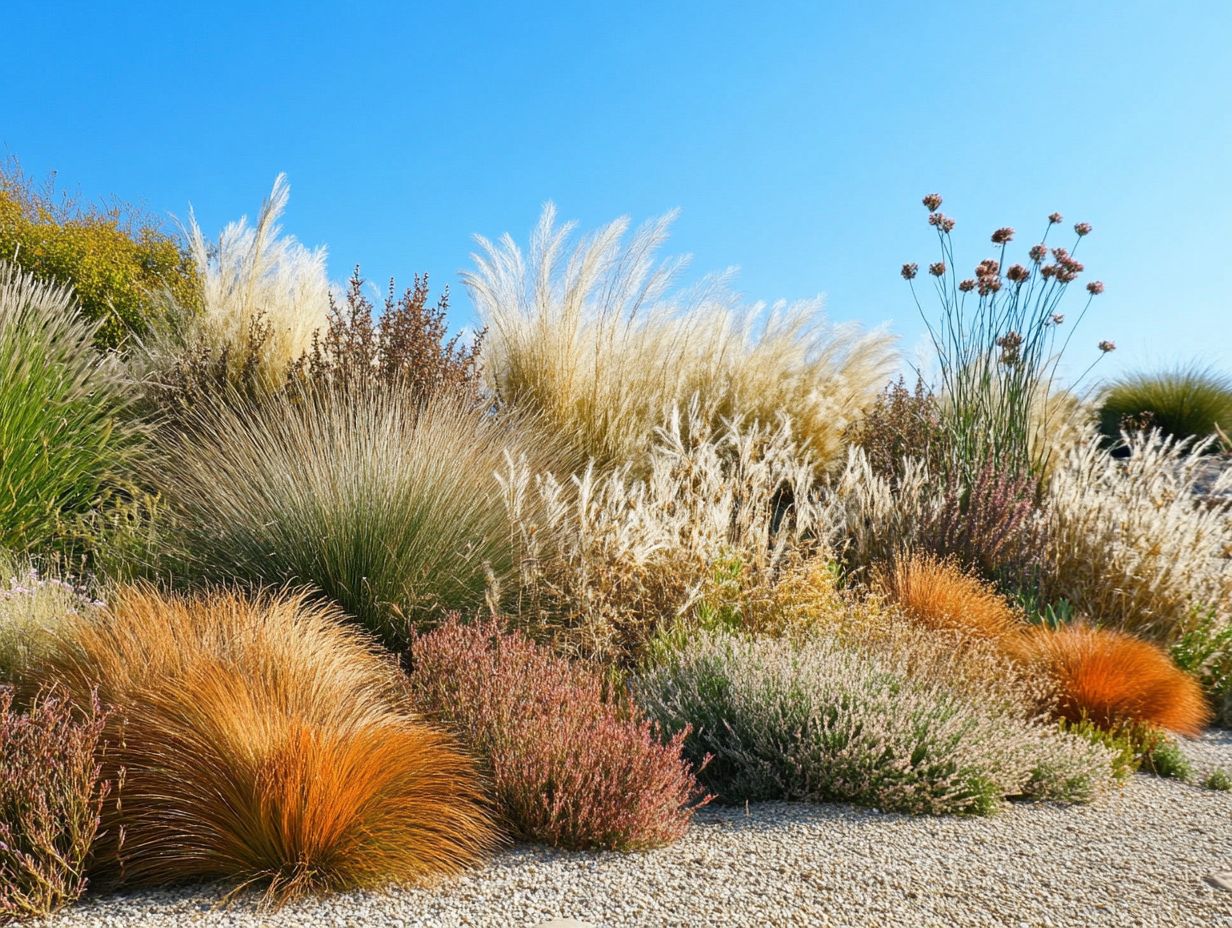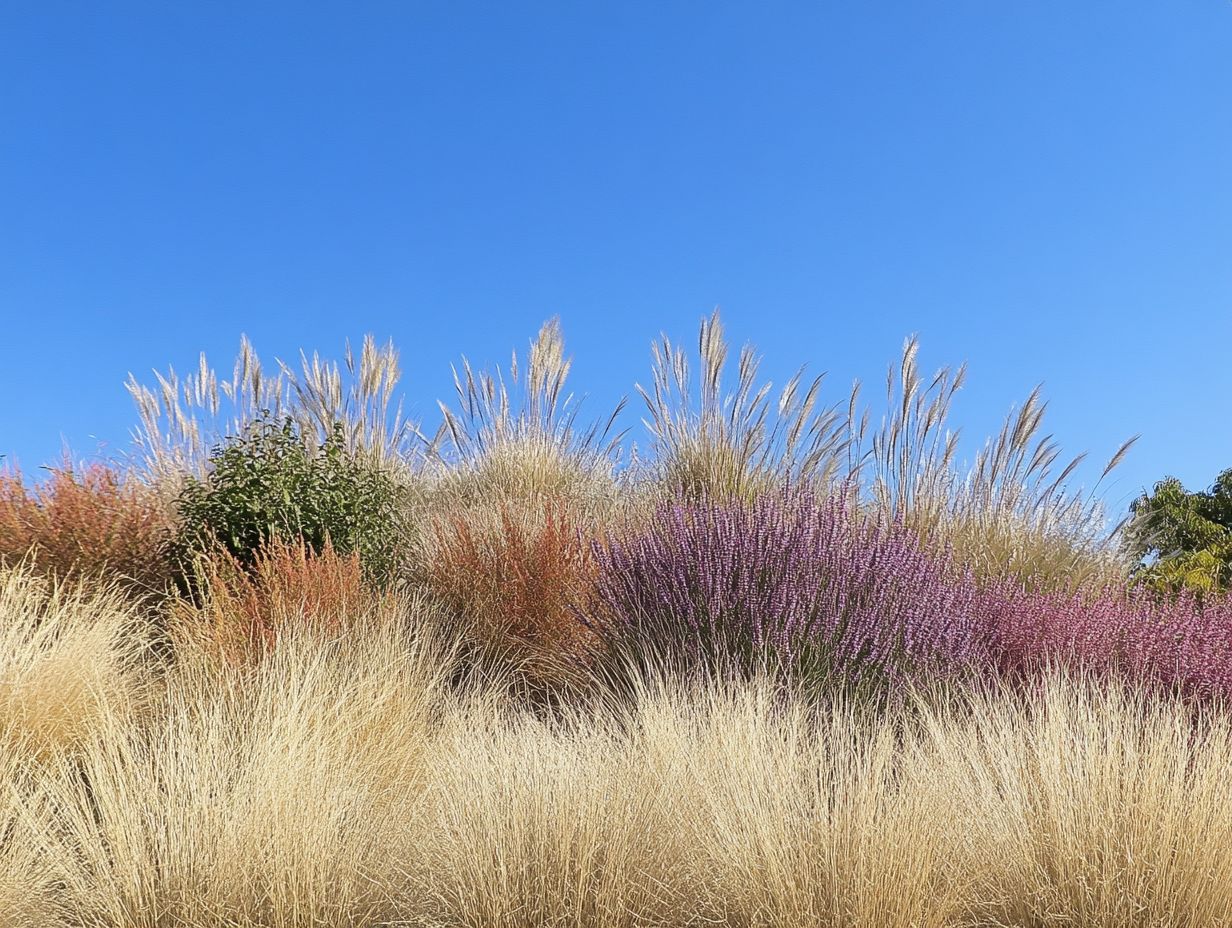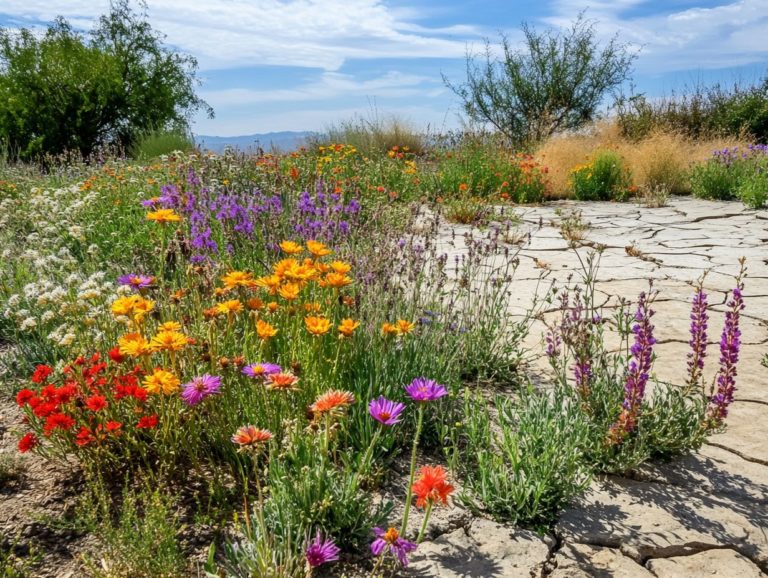What Are the Most Resilient Drought-Tolerant Grasses?
Discover why drought-tolerant grasses are essential for your garden in an era of climate change. These resilient plants not only conserve water but also promote sustainability and reduce maintenance costs.
This article delves into what makes certain grasses adept at thriving in dry conditions. You ll discover the myriad benefits of integrating them into your landscape and the diverse types available from warm-season to cool-season varieties. Get ready to explore the top picks for resilience and learn best practices for maintaining a vibrant, water-efficient lawn.
Join us on this journey as we explore the vital aspects of drought-tolerant grasses and unveil how they can elevate your outdoor space.
Contents
- Key Takeaways:
- Understanding Drought-Tolerant Grasses
- Benefits of Using Drought-Tolerant Grasses
- Types of Drought-Tolerant Grasses
- Top Drought-Tolerant Grasses for Resilience
- How to Maintain Drought-Tolerant Grasses
- Frequently Asked Questions
- What Are the Most Resilient Drought-Tolerant Grasses like Bermudagrass and Buffalograss?
- What Are the Benefits of Planting Drought-Tolerant Grasses?
- Can Drought-Tolerant Grasses Survive in All Climates?
- How Often Do Drought-Tolerant Grasses Need to be Watered?
- What Are Some Tips for Maintaining Drought-Tolerant Grasses, including varieties such as Red fescue and Fountain grass?
- Can Drought-Tolerant Grasses Be Used for Sports Fields and Playgrounds?
Key Takeaways:

- Drought-tolerant grasses have the ability to withstand long periods of drought while maintaining their growth and green color.
- Using drought-tolerant grasses can save on water usage and have a positive impact on the environment, reducing maintenance costs.
- Some of the most resilient drought-tolerant grasses include warm-season grasses such as Bermudagrass and cool-season grasses such as Tall Fescue, as well as native grasses like Buffalo Grass and non-native grasses like Zoysia Grass.
Understanding Drought-Tolerant Grasses
Understanding drought-tolerant grasses invites you to explore their remarkable adaptations that allow them to flourish in extreme climates, especially in regions facing water scarcity.
These resilient species, including Bermudagrass, Buffalograss, and Tall Fescue, have specific traits to maintain a vibrant lawn even in sweltering summer heat. By looking into their root structures and growth habits, you can appreciate how these grasses conserve water and enhance soil health.
This positions them as excellent choices for sustainable landscaping in drought-prone areas.
What Makes a Grass Drought-Tolerant?
The key factors contributing to a grass’s drought tolerance lie in its remarkable adaptations in their root systems. These adaptations enable grasses to tap into deep moisture reserves within the soil and conserve water during extreme heat and limited rainfall.
Take Bermudagrass, for instance. It boasts extensive root systems that can reach significant depths, diligently seeking out water when surface moisture is hard to come by. Similarly, Buffalograss, with its fibrous roots and minimal leaf area, excels at minimizing transpiration (the process of water loss from plants), effectively retaining essential moisture during prolonged dry spells.
These morphological traits, paired with physiological adaptations such as the ability to slow metabolism during drought, give certain grasses the power to flourish in arid environments. They showcase impressive resilience and flexibility. Ultimately, grasping these characteristics is essential for selecting the right grass species for sustainable landscaping in water-scarce regions.
Benefits of Using Drought-Tolerant Grasses
Utilizing drought-tolerant grasses offers a wealth of benefits, particularly in areas facing persistent drought. These hardy species demand significantly less water and fertilizer, allowing you to adopt a low-maintenance approach to lawn care.
You can still enjoy a vibrant, resilient lawn that withstands summer heat and regular foot traffic. Their adaptability in extreme environments enhances soil health, paving the way for long-term sustainability in both residential and commercial landscaping.
Don t miss out on transforming your landscape today! Explore the best drought-tolerant grasses for your lawn and make a difference!
Environmental and Cost Savings

The environmental advantages of employing drought-tolerant grasses go well beyond just conserving water. They also significantly enhance soil health and lessen your dependence on irrigation systems.
By requiring considerably less water, these grasses not only help you save on utility bills. They also play a crucial role in preserving local water resources, especially in areas grappling with persistent drought.
Their deep root systems improve soil structure and foster a greater variety of plant and animal life, creating an environment where beneficial microorganisms can flourish.
This harmonious relationship promotes enhanced nutrient cycling, the natural process of nutrients moving through the environment, which can diminish your reliance on chemical fertilizers.
Embracing these sustainable landscaping practices gives you and your community the power to effectively combat soil erosion. This delivers both economic savings and environmental resilience in the face of climate change.
Types of Drought-Tolerant Grasses
When choosing the ideal grass species for drought-prone areas, you must grasp the nuances between warm-season and cool-season grasses. Each type brings its own set of characteristics tailored to specific climate conditions.
Warm-season grasses, such as Bermudagrass and Zoysia grass, flourish under intense summer heat. In contrast, cool-season grasses, like Kentucky bluegrass and Tall fescue, thrive in cooler temperatures and may go dormant during peak heat.
By understanding these differences, you can make informed choices that enhance your landscape s resilience while promoting sustainability.
Warm Season vs. Cool Season Grasses
Warm-season grasses, like Bermudagrass and Buffalograss, are expertly designed to thrive in higher temperatures. They handle drought conditions far better than their cool-season counterparts, such as Kentucky bluegrass.
These resilient varieties truly come into their own during the scorching summer months. They often reach their peak growth when the mercury rises, making them the ideal choice for regions that bask in long, hot summers.
In contrast, cool-season grasses, including fescue and ryegrass, excel in the cooler temperatures of spring and fall. They flourish in moisture-rich, lush conditions.
While cool-season grasses may falter under intense heat or drought, warm-season grasses, equipped with deep root systems, showcase remarkable drought resistance. This positions them as the perfect solution for areas prone to extended dry spells.
Grasping the unique characteristics and advantages of each type can significantly elevate your lawn care and landscaping strategies.
Native vs. Non-Native Grasses
Native grasses are often more drought-resistant than non-native varieties, like Prairie dropseed and California native sod. They adapt more easily to local climates, making them ideal for sustainable landscaping in your area.
Their resilience ensures survival during dry spells and fosters biodiversity in ecosystems grappling with climate change. Since native grasses co-evolved with local plants and animals, they play vital roles in supporting insect populations and providing essential habitats for wildlife.
<pOn the flip side, while non-native grasses may tempt you with their initial lushness, they often demand more water. They can disrupt local ecosystems, leading to diminished soil health and biodiversity.
Understanding these intricate dynamics is crucial for anyone aiming to craft a sustainable landscape that respects and enhances the ecological fabric of the area.
Top Drought-Tolerant Grasses for Resilience

When you think about the finest drought-tolerant grasses for resilience, Bermudagrass, Buffalograss, and Tall Fescue immediately come to mind. These grasses possess robust characteristics that allow them to thrive in the relentless summer heat.
With their robust features, these grasses not only survive but thrive in the relentless summer heat! Choose your drought-tolerant grass today to ensure a vibrant and sustainable landscape for tomorrow!
Characteristics and Ideal Growing Conditions
Drought-tolerant grasses possess remarkable characteristics, including extensive root systems and an impressive ability to withstand fluctuations in soil temperature. They expertly maintain a vibrant lawn even in drought conditions.
These grasses thrive on less water compared to traditional varieties, thanks to their adaptability to diverse environmental conditions. Their unique natural characteristics allow them to minimize water loss through reduced water evaporation, making them efficient in water usage.
Many resilient varieties can effectively capture and utilize moisture from infrequent rain, showcasing an amazing ability to sustain growth during dry spells. This amazing resilience boosts turf density and creates a lush, green lawn that stands out. Certain species have even evolved to tolerate heat, making them an excellent choice for regions grappling with increasing water scarcity.
How to Maintain Drought-Tolerant Grasses
To maintain drought-tolerant grasses, adopt a series of best practices designed to encourage healthy growth while minimizing water consumption and reducing overall maintenance efforts. This will help you create a flourishing, low-maintenance lawn that thrives even during the scorching summer months.
Best Practices for Healthy Growth
Implementing best practices for healthy growth requires embracing effective water conservation techniques, managing fertilizers wisely, and establishing strategic mowing schedules that support drought-tolerant grasses.
Prioritize regular soil testing and selecting the right grass types to enhance resilience. This will help you monitor nutrient levels for drought-resistant options and ensure your grasses receive the right fertilizers at just the right moments. Aerating the soil, which helps air and water reach the roots, and incorporating grasses like Tall Fescue and Kentucky Bluegrass can work wonders, improving water infiltration and promoting better root health.
Don t overlook the power of mulching, especially with drought-tolerant grasses like St. Augustine and Centipede grass. It s essential for retaining moisture and suppressing pesky weeds that compete for precious resources. Additionally, selecting the right species adapted to your specific climatic conditions can significantly elevate performance, creating a robust ecosystem that includes California native sod and Seashore Paspalum that thrives even in tough environments.
Frequently Asked Questions

What Are the Most Resilient Drought-Tolerant Grasses like Bermudagrass and Buffalograss?
The most resilient drought-tolerant grasses include Bermuda grass, Zoysia grass, buffalo grass, fescue grass, blue grama grass, and switchgrass.
What Are the Benefits of Planting Drought-Tolerant Grasses?
Drought-tolerant grasses require less water and maintenance, making them ideal for regions like Nevada, making them a cost-effective and environmentally friendly option for landscaping. They also have deep root systems that help prevent erosion and provide a natural habitat for wildlife.
Can Drought-Tolerant Grasses Survive in All Climates?
While drought-tolerant grasses are more resilient in dry conditions, they may not thrive in extremely cold or humid climates. It’s essential to research the specific climate requirements of each grass before planting.
How Often Do Drought-Tolerant Grasses Need to be Watered?
Drought-tolerant grasses are designed to survive with minimal watering, but they still require some moisture to stay healthy. During the summer months, they should be watered once or twice a week, while in cooler months, watering can be reduced to once every two or three weeks.
What Are Some Tips for Maintaining Drought-Tolerant Grasses, including varieties such as Red fescue and Fountain grass?
To keep drought-tolerant grasses healthy, mow them at the recommended height and fertilize them with a slow-release fertilizer. It’s also beneficial to remove thatch build-up and aerate the soil every 2-3 years.
Can Drought-Tolerant Grasses Be Used for Sports Fields and Playgrounds?
Yes, many types of drought-tolerant grasses, like Hybrid Bermuda and Bahia grasses, are popular choices for sports fields and playgrounds. These grasses are durable and can withstand heavy foot traffic.
They recover quickly from damage, making them ideal for active areas. With their resilience, they help ensure a safe and fun environment for everyone.






